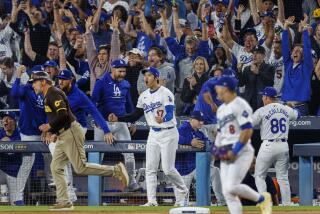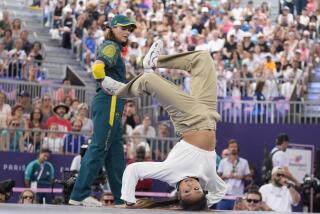Things Might Not Be as Bad as They Seem
In keeping with recent NBA history, the worst of times reigned right up until Game 5 of the Finals, when Big Shot Robert Horry, the accessory without which no dynasty is complete, made the shots that woke up fans around the world.
To that point, it seemed as if the perfect storm that blew in the day Michael Jordan retired in 1998 was still raging.
Jordan’s departure was followed by the lockout, the recession, the flight to cable after longtime broadcast partner NBC offered a 25% cut, the decline of the Eastern Conference, the decline of the Finals, the decline of scoring and finally (sigh) the decline of the Lakers.
This postseason looked promising before David Stern threatened to banish Jeff Van Gundy for life and broke off talks with the union, raising the prospect of another lockout; Shaquille O’Neal and Dwyane Wade got hurt; Larry Brown’s negotiations eclipsed the East finals; Joe Johnson’s injury turned the West finals into a walkover; the Pistons no-showed for Games 1 and 2 of the Finals while renewing their complaints that the league, the referees and the rest of the country were conspiring against them; the Spurs no-showed for Games 3 and 4; and the whole thing was eclipsed by Phil Jackson’s return.
Then, out of nowhere, came two classics, Game 5 with Horry’s astounding performance and Game 6 with the Pistons’ brave response, producing the first Game 7 in 11 years
By then, you might have thought the league was hanging on by a thread but was saved by a socko finish.
In fact, it still turned out to be the second-lowest rated Finals ever ... and the league -- apart from its image -- is in good shape.
All that has happened since 1998 is that the NBA has fallen back to its level at the end of the ‘80s -- which was its high point until Jordan and the Bulls carried it to unimagined heights in the ‘90s.
In the ‘80s, the golden decade in which Magic Johnson’s Lakers or Larry Bird’s Celtics appeared in every Finals, the NBA averaged a 13.9 rating (not counting the 1980 and 1981 tape-delayed series on CBS.)
That was about 60% of the 22.4 rating baseball averaged for the World Series in the ‘80s.
Since 1998, the NBA Finals have averaged a 10.2 rating, about 70% of the World Series’ 14.1.
Even if you narrow it down to the NBA’s last three promotion-challenged seasons on ABC, the Finals have averaged an 8.7, still about 60% of the 13.5 rating for the last three World Series.
Jordan’s departure saw Stern trumpeting his young stars, determined to preserve the league’s gains in the ‘90s, which soon proved impossible.
By this spring, when the loss of the Lakers as a marquee draw led to a further swoon, people were sneering at the NBA as “the new hockey.” Even as the Finals ended on an up note, headlines screamed the bad news anew.
“What if They Held an NBA Finals and No One Bothered to Watch?” asked the New York Times.
“TV ratings speak volumes: NASCAR in driver’s seat, NBA on bench,” said USA Today.
This followed the conventional method of measuring success, not by actual ratings but by comparisons to the preceding season. This is key for sponsors making million-dollar buys but downplays the actual hierarchy.
A 100% jump from a 2.0 to a 4.0 makes you sizzling. A 25% decline from 10 to 8 makes you a disease. Nevertheless, an 8 rating is still twice as big as a 4, which along with the number of hours of programming provided, is the basis of rights fees.
Suggesting the NBA still carries a lot of weight (it’s that or the networks are a bunch of suckers), it gets a healthy $766 million annually to baseball’s $558 million and the NCAA tournament’s $565 million.
Golf in the Tiger Woods era is supposed to be red-hot and gets lavish and reverential coverage. Nevertheless, with Tiger making a dramatic late charge, last weekend’s final round of the U.S. Open drew a 5.6 rating ... 36% smaller than the 8.8 the NBA got for that night’s Game 5.
In fact, the lowest-rated game of what started out as a much-scorned NBA Finals (6.9) was still 19% higher than the final round of the Open.
Then there’s NASCAR, which is the current rave after pulling off the hardest trick of all, carving out a niche of its own alongside the other sports.
Nevertheless, it’s still only a medium-size niche. The USA Today story trumpeting NASCAR’s triumph over the NBA reported that Fox’s Nextel Cup -- with only one event a week, like football -- was averaging a 6.0 rating.
Among pro leagues, only the NFL is in better shape than the NBA, which, for all its strife, remains an admirably run league. It has labor peace again, the industry is profitable, the average player is the highest paid in sports at $4 million a season and the system allows small markets to compete.
Nevertheless, perception is reality and it isn’t a good idea to keep losing viewers in any case, so Stern had better not rest on his laurels, if he can find any.
How about starting Finals games early enough to get them over by 11 p.m. Eastern?
Forget that “coverage starts at 8:30” scam. The games started at 9:17 p.m. in the East and approached midnight. How about starting at 8:30 with two-minute commercial breaks, instead of five?
It’s true that the World Series runs even later -- but its ratings are off 50% from their peak in the ‘80s, just as the NBA’s are off 50% from their peak in the ‘90s.
Even on Sundays, when they didn’t have to wait for the West Coast audience to get home from work, Finals games started at the same time. Eastern viewers who had to be up at 7 a.m. might not have been keen to stay up until 11 just to see the start of the second half so they could tell if the game was going to be good.
How about scoring a few more points?
Even with the Suns, Mavericks, Nuggets, SuperSonics, Wizards, Magic and Nuggets turning it up this season, it’s not a coincidence the Finals came down to two tough defensive teams and Game 7 was a grinding, low-scoring, 81-74 affair.
“People talk about a new way to play basketball,” former Piston coach Chuck Daly said last week in Detroit. “This is what wins, teams with a lot of big, tough guys.”
That’s the problem.
Bruce Bowen’s artistry, as he bumped, attached himself to and entwined himself with Richard Hamilton was impressive, but this isn’t football or wrestling. Last season Stern helped the up-tempo teams by telling the referees to allow less contact. Now he should finish the job and take out all contact.
At the end of Daly’s Bad Boy era, Stern threw in with Jordan and the Bulls, protecting them from the teams that wanted to chop them down to size, literally, by enacting rules against flagrant fouls, such as John Starks’ memorable/scary flying clothesline of Scottie Pippen in the 1992 Knicks-Bulls series.
In a little-noted irony, Stern was legislating against the hometown Knicks and Pat Riley’s “game of force.” Of course, it also led to the most prosperous era in NBA history.
Prosperity isn’t the problem, but convincing anyone of that at the moment is.
Faces And Figures
Here’s what we know about Tuesday’s draft: Milwaukee is set on Andrew Bogut at No. 1. Here’s what we don’t know: Everything else. Atlanta is thought to be set on Marvin Williams at No. 2, but there’s talk he might drop. Portland at No. 3 is still focused on high schooler Gerald Green but considering taking one of the two point guards, Chris Paul and Deron Williams. No. 4 New Orleans will choose between Paul and Deron Williams, or take whichever drops. No. 5 Charlotte would love to trade up for local favorites Marvin Williams or Paul but doesn’t want to give up its second pick at No. 13 and could settle for Danny Granger. Utah at No. 6 wants to trade up for one of the top two point guards, could settle for Raymond Felton or go big with Channing Frye. No. 7 Toronto needs players at any position (Martell Webster?). The Knicks at No. 8 want Frye. The Warriors at No. 9 wanted Frye but he’ll probably be gone, so everyone is penciling in Hakim Warrick.
The Lakers at No. 10 reportedly wanted to trade up for Green, but Portland wasn’t interested in Caron Butler, Devean George, et al. If they stay at No. 10, they’re thought to be focusing on 6-11 prep center Andrew Bynum, who is thought to have a promise from a top-10 team. Some people think it’s the Knicks and some that it’s the Lakers. If the Lakers don’t take Bynum, they’re thought to go for Webster, the prep guard, or 6-9 Spaniard Fran Vasquez. Orlando at No. 11 wants a point guard (Felton?). The Clippers at No. 12 are, indeed, intrigued by 6-8 Russian Yaroslav Korolev, as has been generally reported.
More to Read
Go beyond the scoreboard
Get the latest on L.A.'s teams in the daily Sports Report newsletter.
You may occasionally receive promotional content from the Los Angeles Times.










